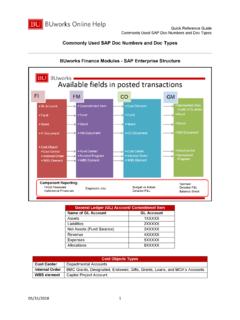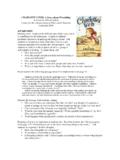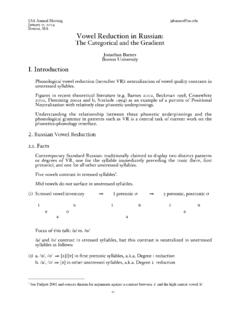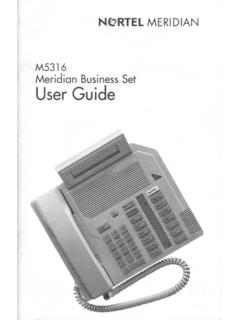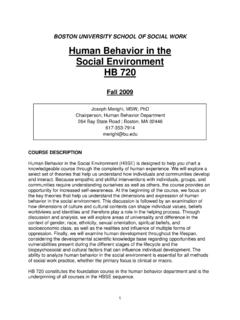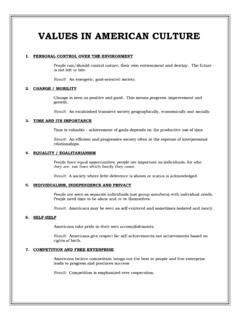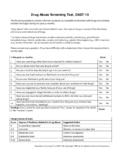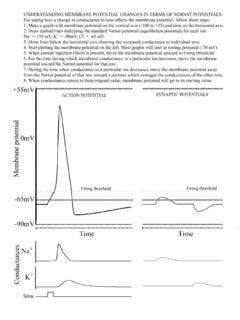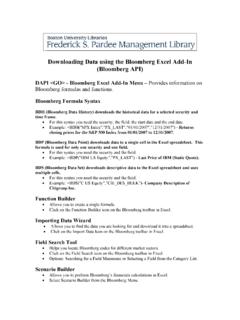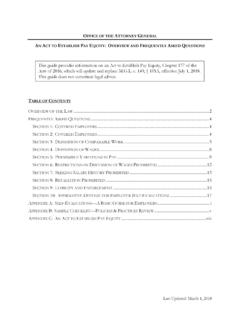Transcription of The Law Student’s Quick Guide to Legal Citation
1 The Law Student s Quick Guide to Legal Citation by The Boston University School of Law Legal Information Librarians Edited by Steve Donweber Copyright 2012 Pappas Law Library, Boston University School of Law iTable of Contents Introduction to Legal Citation .. 1 Using The Bluebook .. 4 Law Review Footnotes v. Court Documents and Legal Memoranda .. 8 Case Names .. 9 Books .. 10 Court Rules .. 11 Abbreviations .. 12 Spacing .. 13 Signals and Parentheticals .. 15 Signals .. 15 , .. 15 See .. 16 See also .. 17 See, , .. 18 Accord .. 19 Cf.. 20 Contra .. 20 ii But see .. 21 See generally .. 21 A Final Note on Signals .. 21 Parentheticals .. 22 Citing Cases.
2 24 Generally .. 24 Reporters .. 24 Federal Reporters .. 25 Regional (State) Reporters .. 26 Case Name .. 27 Case Citation Information .. 27 Abbreviations in Case 27 Parallel Citations .. 28 Unpublished Cases .. 29 Westlaw Example .. 29 LexisNexis Example .. 30 Citing Statutes .. 31 Generally .. 31 Year of the Code .. 32 iii Federal Statutes .. 33 Statutory Codes .. 33 Session Laws .. 34 State Statutes .. 34 Statutory Codes .. 34 Session Laws ..35 Citing Secondary Sources .. 36 Dictionaries .. 36 Legal Encyclopedias .. 37 Journals and Periodicals .. 38 Consecutively Paginated .. 38 Non Consecutively Paginated .. 38 Newspapers .. 39 Massachusetts Practice .. 39 Multi Volume Treatises.
3 40 Single Volume Treatises and Monographs .. 41 Short Citation Forms .. 42 Citing to Cases, Statutes, and Secondary Sources that you Find on Westlaw and LexisNexis .. 44 iv Conclusion .. 45 Additional Reading .. 47 [1] Introduction to Legal Citation Legal Citation is the method by which lawyers, law students , professors, and judges refer to the sources, whether primary or secondary,1 that they rely upon when drafting court documents or Legal memoranda, law school assignments, law review articles, and judicial opinions. Citations are shorthand notations that permit the identification and location of a particular source. Thus, elements of a Citation generally include what the source is, where it can be found, the year it was created or went into effect, and for all primary sources and some secondary sources, the jurisdiction to which it applies.
4 Because we rely on different sources for different reasons, Legal Citation also includes the use of signals, which introduce citations and explain to the reader the Citation s purpose, and explanatory parentheticals, which provide further details on a source's relevance to the author's proposition. Mastering Legal Citation takes practice, patience, and strict attention to detail. It means mastering the profession wide standards for Legal Citation , which are set forth in The Bluebook: A Uniform System of 1 Primary sources include cases, statutes, and regulations. Secondary sources include hornbooks, monographs, Legal encyclopedias, law review articles, and treatises.
5 [2] Citation ,2 published by the Columbia, Harvard, and University of Pennsylvania Law Reviews, and the Yale Law Journal. At its inception, The Bluebook was a modest undertaking designed only to deal with the more common abbreviations and [ Citation ] forms to which one has occasion to refer. 3 Needless to say, The Bluebook is modest no longer. It has grown from a 26 page pamphlet first published in 19264 to a 511 page behemoth when the latest edition (the 19th) came out in This explosion in Citation forms, rules, and complexity has made The Bluebook very difficult to use, particularly for new law students . For that reason, we have created this Quick Guide , which, happily, is only slightly longer than the original A Uniform System of Citation published in 1926.
6 Be forewarned; this Quick Guide is not It covers only (1) the difference 2 This Guide and its authors are in no way affiliated with The Bluebook or any of the law reviews or journals that compile and edit it. 3 A UNIFORM SYSTEM OF Citation 1 (Harvard Law Review ed., 1926). 4 See id. 5 See THE BLUEBOOK: A UNIFORM SYSTEM OF Citation (Columbia Law Review Ass'n et al. eds., 19th ed. 2010) ("BLUEBOOK"). 6 By design. [3] between Citation forms in law review footnotes and those in Legal memoranda and court documents, (2) abbreviations, (3) the use of signals and parentheticals, (4) basic Citation forms for cases, statutes, and secondary sources, (5) short Citation forms, and (6) how to cite cases, statutes, and secondary sources when you find them online rather than in We ve limited the Quick Guide s scope to avoid overwhelming the new student with a massive and confusing array of Citation forms, abbreviations, and other rules that are seldom, if ever, used during the first year.
7 Rather, we focus only on the areas (when it comes to Legal Citation ) that we believe are most valuable to new law students . Yes, The Bluebook is daunting, but it need not be your Nor, of course, should it be your master. However, it can be your friend if certain steps are followed and a certain proficiency is We hope this Quick Guide helps. Good luck! * * * 7 For everything else, you must, of course, consult The Bluebook itself. 8 Bane. n. "a source of harm or ruin." WEBSTER'S SEVENTH NEW COLLEGIATE DICTIONARY 68 (1963) 9 This tidy bit of philosophy is based on something that Pliny the Elder likely said. Or, if not, probably should have.
8 [4] Using The Bluebook First off, don't think too much about The Bluebook. It's far too painful. Nevertheless, it is important to understand The Bluebook's purpose and its structure. Once you get those two things down, using The Bluebook becomes much easier. As to The Bluebook's purpose, or more generally, as to the purpose of uniform Legal Citation , it is twofold: (1) the identification of a source, and (2) where to find it. Judge Richard Posner, even though a harsh critic of The Bluebook, agrees: A system of Citation forms has basically two functions: to provide enough information about a reference to give the reader a general idea of its significance and whether it s worth looking up, and to enable the reader to find the reference if he decides that he does want to look it This purpose is quite vital in both Legal practice and scholarship.
9 How does knowledge of The Bluebook's purpose help us use it? Well, if the purpose is to help us identify sources and then locate them, it's obvious that Citation format, at least at its most basic level, must be standard and uniform. So, for example, every 10 Richard A. Posner, The Bluebook Blues, 120 YALE 850, 852 (2011). [5] published United States case, whether state or federal, has the following format: [case name], [volume number] [reporter in which case is published in print] [page number on which case begins] ([court that decided case]11 [year case was decided]). Actual examples using this structure are below:12 United States v. Pepperman, 976 123 (3d Cir.)
10 1992). Costa v. Boston Red Sox, 809 1090 (Mass. App. Ct. 2004). v. Philadelphia Phillies, 940 336 (Pa. 2008). Due to uniform Legal Citation , we instantly recognize these examples as cases and we also immediately know, more specifically, where the case is published in print, the court that decided the case, and when the case was decided. This is very valuable information, and with uniformity, we get it at a glance. The same principles apply to most other Citation formats as well. The idea is that even if the specifics 11 For cases where the Citation to the reporter clearly identifies the court (for example, Flood v. Kuhn, 407 258 (1972)), there is no need to identify the deciding court in the parenthetical.
